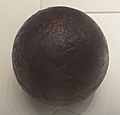Hanover (ship) facts for kids
Quick facts for kids History |
|
|---|---|
| Name | Hanover |
| Launched | 1757 |
| Fate | Wrecked, 13 December 1763 |
| General characteristics | |
| Type | Brigantine |
| Length | 100 ft (30 m) |
The Hanover was a special kind of ship called a brigantine. It had two masts and was a "packet ship." This means it carried mail, passengers, and valuable goods across the sea. The Hanover was part of the Falmouth Post Office Packet Service in Great Britain. This service ran for many years, from 1688 to 1852.
Sadly, the Hanover was wrecked on December 13, 1763. It was sailing from Lisbon, Portugal, back to Falmouth, England. A very strong storm, called a gale, pushed the ship onto the shore. The ship's captain was Joseph Sherbourne. Out of 27 crew members and 40 passengers, only three people survived. The place where the ship was wrecked, near Perranporth, is now known as Hanover Cove. The ship was carrying a lot of gold and other valuable items. Most of these treasures were found and recovered soon after the wreck.
Contents
Legal History of the Wreck
The wreck of the Hanover made an important mark in legal history. In 1765, an iron trunk filled with bullion (gold or silver in bulk) was found from the wreck. The insurance companies had already paid the ship's owners for the lost cargo. This event led to a new rule: if insurance companies pay for lost goods, and then the owners find those goods later, the insurance companies have the right to get their money back. This rule is still used today.
Discovery of the Wreck Site
The wreck of the Hanover was discovered much later, in 1994. A local diver named Colin Martin found it. The seabed had changed, revealing parts of the old ship. The wreck was identified when the ship's bell was found. The bell was clearly marked with the ship's name.
Protecting the Wreck
The Post Office, which owned the Hanover, paid for archaeologists to study the wreck. In 1996, they suggested that the site should be protected. This protection would be under the Protection of Wrecks Act. However, the wreck was not immediately protected.
On July 19, 1997, the wreck site finally received emergency protection. This happened after about fifty guns were found. Also, a salvage rig was set up next to the wreck, which was disturbing the site. The diver who found the wreck was then given a special license. This allowed him to dig at the site under the watch of archaeologists. The plan was to show the items found in a local shipwreck museum.
Artifacts Found
Many items have been brought up from the Hanover wreck site. These include muskets, cannonballs, and parts of the ship. Even the captain's ring was found. After these discoveries, sand was put back over the wreck site. This helps to protect it from further damage. The Hanover wreck is now a Protected Wreck. It is managed by an organization called Historic England.
Later Investigations
In 2016, a group called Cotswold Archaeology was asked by Historic England to study the Hanover wreck. They used marine assessment to see if the site should still be protected. Some earlier reports had questioned if the wreck was definitely the Hanover. There were also concerns about how the salvage work had been done. Some people felt that the finds and information were not recorded in a professional way.
Images for kids





